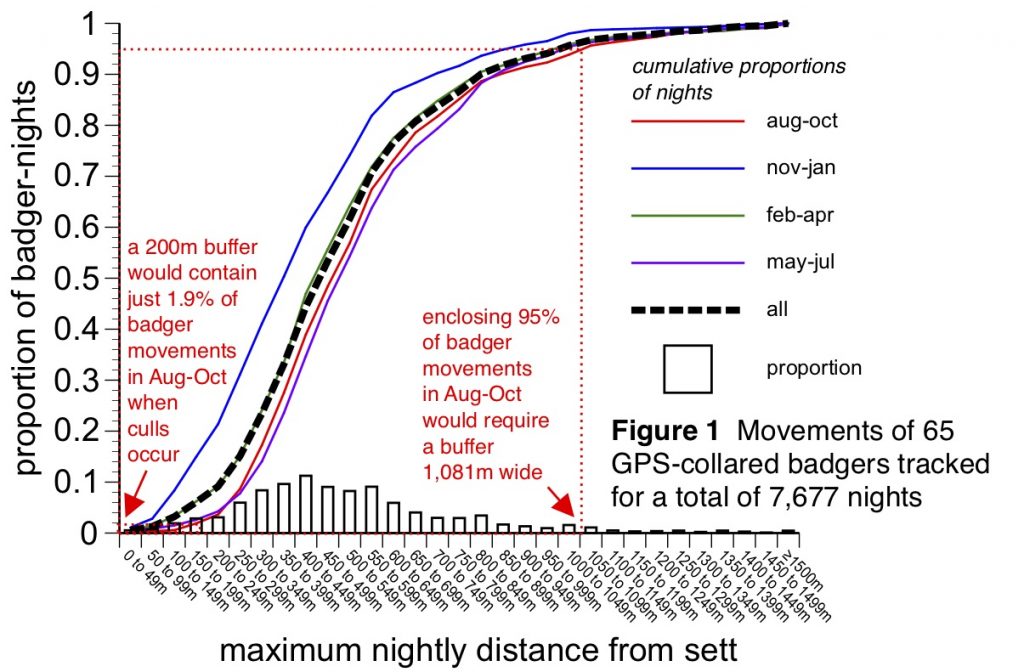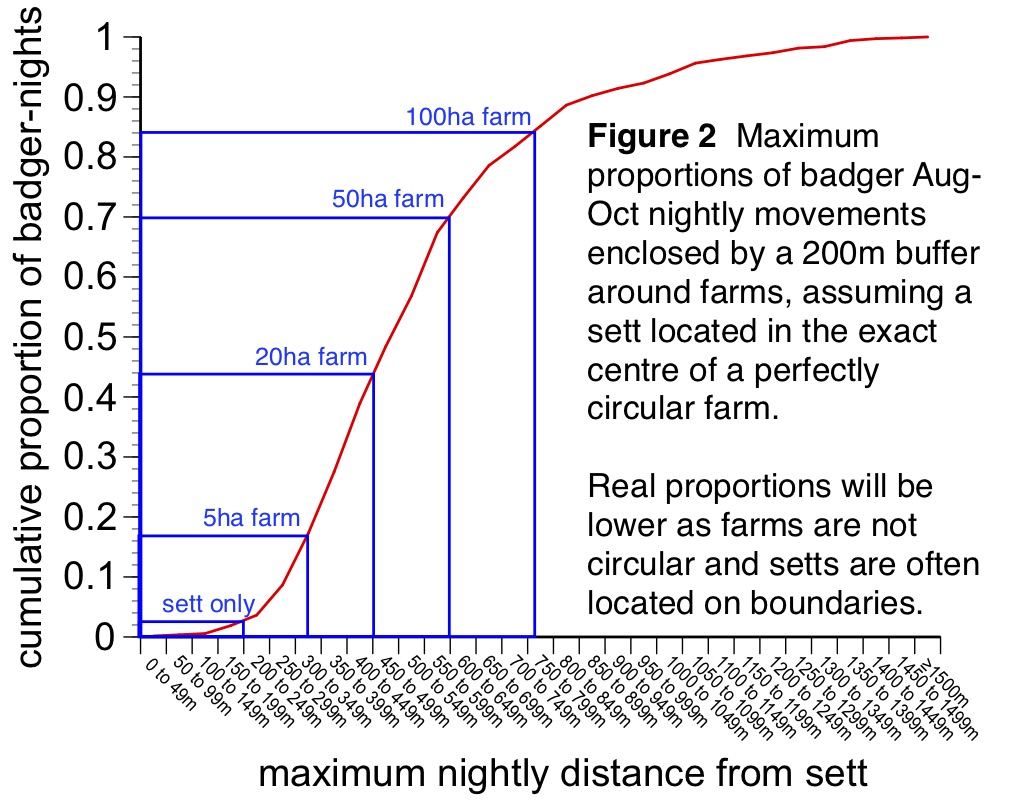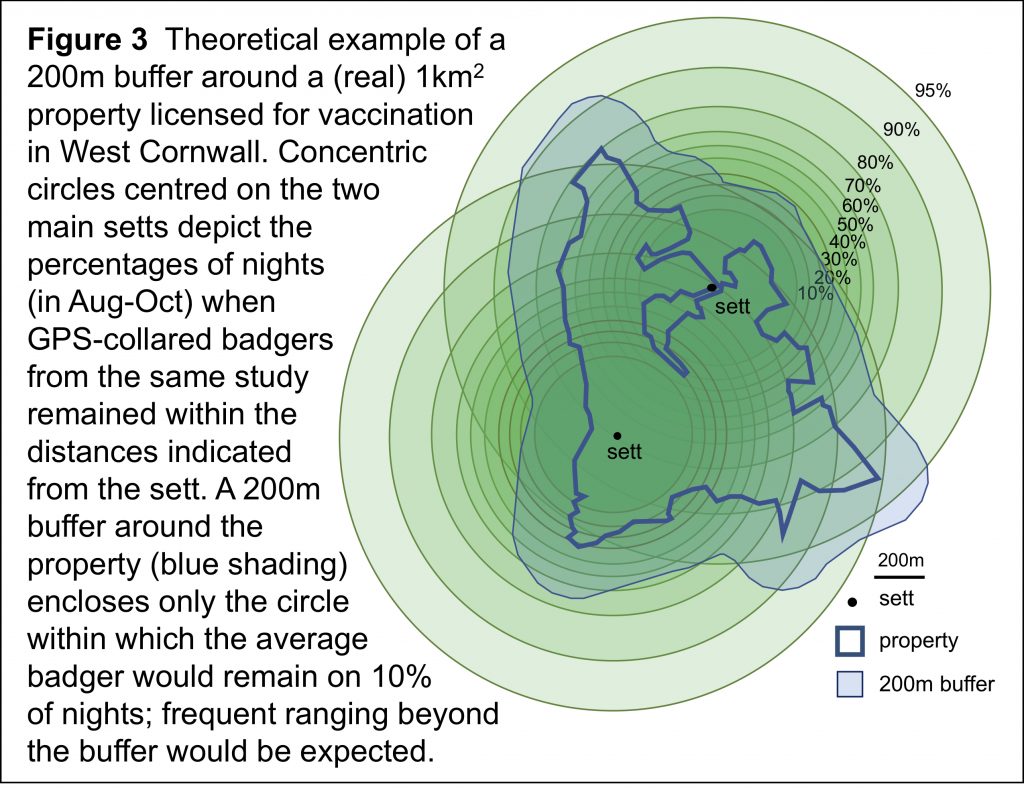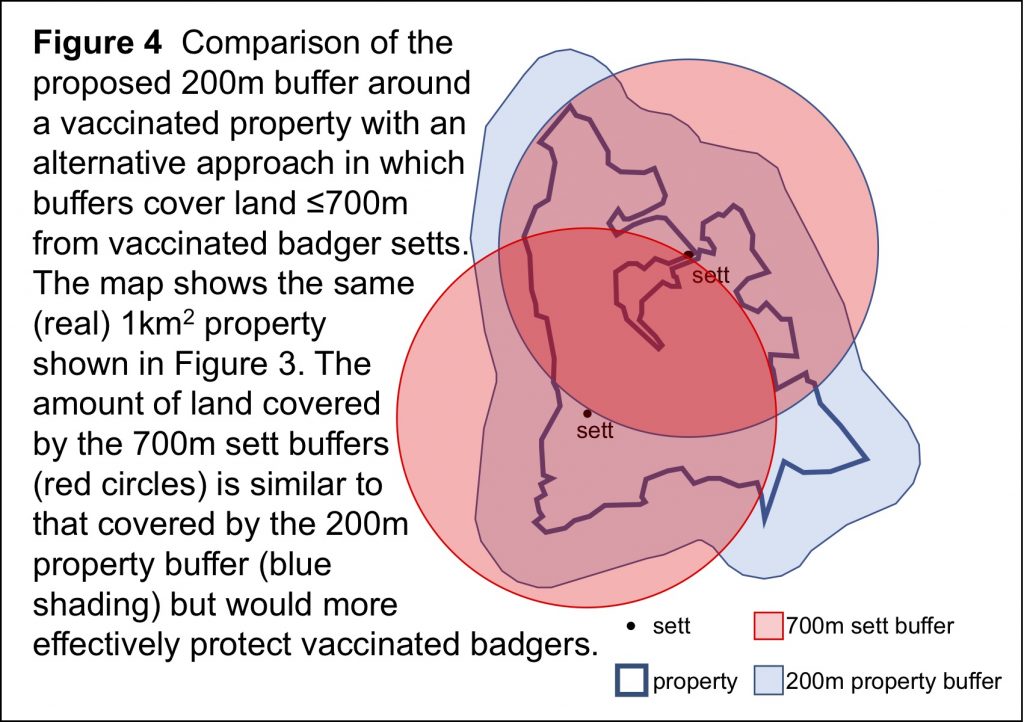1 Summary
The government is consulting on whether to license no-cull zones around badger vaccination sites. You can have your say here, though you should first read the consultation document, which is available here. The consultation closes on 26 June 2020. In this blog, I set out my response to the consultation. Each of the subheadings below addresses one of the questions in the consultation. If you respond, make sure you answer the specific questions.
In summary, my view is that protecting vaccinated badgers from culling is a good idea, both because culling is likely to undermine the effectiveness of vaccination, and because it is inconsistent for the government to financially support, and license, the vaccination and culling of the same badgers. However, as currently formulated, the government’s proposals are problematic because they:
• undermine the government’s policy of transition from culling to vaccination, by fostering culling in regions where vaccination is increasingly important
• will fail to protect vaccinated badgers, because the proposed minimum buffer is too narrow to accommodate typical badger movement
• inexplicably apply only to the Edge Area, even though the government has committed to also supporting badger vaccination in the High-Risk Area
• constrain the expansion of vaccination by allowing no-cull buffers to be removed but not added in the course of a cull licence
• require vaccination licensees to negotiate with cull licensees, while simultaneously preventing such negotiation by withholding information on the locations of cull zones and the identities of cull licensees
• are likely to generate conflict between neighbouring landowners.
A better approach would be to
• use the licensing and financial support systems to actively encourage badger vaccination on large spatial scales
• where buffers are needed, draw wide buffers around specific setts rather than narrow buffers around properties
• encourage and mediate in-person discussion between vaccination and cull licensees
• allow vaccination licensees to request no-cull buffers at any point during a cull licence.
2 Should vaccinated badgers be protected from culling to some degree, to manage delivery of adjoining vaccination and culling?
Yes, it is appropriate to protect vaccinated badgers from culling. Although such protection has been linked to the inconsistency of government using taxpayers’ money both to vaccinate and to cull the same badgers, there are also epidemiological reasons for separating vaccination and culling. Culling alters badgers’ behaviour so that they range more widely, encouraging transmission both among badgers and from badgers to cattle. Instigating such changes on or near vaccinated land is highly likely to undermine the effectiveness of badger vaccination. Since vaccination licences are issued “for the purpose of preventing the spread of disease”, it is appropriate to take measures to avoid undermining the achievement of this purpose.
In contrast, vaccinating close to culled land should have no adverse effects on the outcomes of culling. Hence, there is no comparable need to restrict vaccination conducted in the vicinity of cull zones.
3 If so, to what degree, in what circumstances and subject to what conditions? In particular –
3(i) Should any such protection only be provided to badgers vaccinated in the Edge Area?
The consultation document proposes different approaches to no-cull buffers in the Edge Area and High Risk Area. Buffers would be licensed only for vaccination conducted in the Edge Area, with no formal process to protect vaccination badgers elsewhere. These differing approaches reflect the investment of taxpayers’ money in the Badger Edge Vaccination Scheme, and the legitimate concern that the government should not support the killing of the same animals it has paid to vaccinate.
However, this distinction between the Edge Area and the High Risk Area fails to take account of recent policy changes, specifically the government’s commitment “to support badger vaccination in areas where there is a reservoir of infection in badgers but farmers have decided not to cull or have been unable to organise sufficiently to do so”. As the planned policy transition occurs, taxpayers will presumably be helping to pay for badger vaccination in the High Risk Area as well as the Edge Area. In these circumstances, it would be appropriate to license no-cull buffers in the High Risk Area as well as the Edge Area.
3(ii) Should protection be achieved by means of a no-cull zone?
Some form of no-cull zone would be the most appropriate way to prevent killing of vaccinated badgers. There is no humane way to mark vaccinated badgers in ways which could reliably identify them for an appropriate timescale and which would be consistently visible at the distances over which marksmen operate. The fur-clips currently used to identify vaccinated badgers in the short term last only as long as the next moult. Moreover, enlarging these fur clips to make them visible over long distances is not practicable without anaesthesia.
3(iii) If so, how should the size of the no-cull zone area be determined?
The stated aim of establishing no-cull buffers around vaccinated land is “to reduce the risk of culling vaccinated badgers” while “ensuring that culling can proceed”. Buffers will only reduce the risk of killing vaccinated badgers if they are wide enough to encompass a substantial proportion of badger movements. However, wider buffers will reduce the overall cull area to a greater extent than narrower buffers. The proposed minimum buffer width is 200m, with wider buffers likely to be available only for very large vaccination areas. The ability of no-cull buffers to prevent killing of vaccinated badgers depends upon the probability that badgers will cross the buffer onto surrounding land where culling is licensed. The proposed 200m minimum buffer width was chosen based on an analysis from the Randomised Badger Culling Trial (RBCT) which found that higher-than-average densities of badgers were caught within 200m of inaccessible land. However, this analysis (which I helped to design) did not evaluate badger capture rates across a range of distances; rather, a narrow 200m buffer was deliberately chosen because the analysis was designed specifically to evaluate the RBCT practice of deliberately targeting badgers on inaccessible land by placing cage traps on the nearest accessible land. Hence, this published analysis does not provide an especially useful basis for selecting a suitable width for no-cull buffers to protect vaccinated badgers.
Since the RBCT, more detailed data on badger movement have become available, which allow a better evaluation of the likely impacts of no-cull buffers of various widths. Summary data on the movements of 65 GPS-collared badgers are publicly available from my own team’s scientific study in Cornwall, part-funded by Defra. Data from areas not subjected to culling show that most badgers travel far more than 200m from their setts (Figure 1). In the months of August-October, when most culling occurs, GPS-collared badgers stayed within 200m of their setts on just 1.9% of nights (Figure 1). The area that would enclose badger ranging on 95% of nights during these months would cover land up to 1,081m from the sett (Figure 1).

Although this initial analysis of GPS-collar data suggests that a 200m-wide buffer would be unlikely to protect vaccinated badgers from culling, in practice no-cull buffers would be placed 200m from property boundaries rather than setts. Figure 2 shows the maximum proportions of badger nightly movements that could be enclosed by 200m buffers around properties of various size. These are theoretical maxima, calculated by assuming a perfectly circular farm with a single badger sett in the very centre. Defra data indicate that approximately 60% of farms in England cover ≤0.5km2 (50ha); a 200m buffer around an idealised circular 0.5km2 farm would still only enclose 70% of badger nightly movements from a sett in the farm’s centre (Figure 2).

In practice, farms are not circular and seldom have setts placed perfectly at their central points. Figure 3 shows an example of a real 1km2 farm licensed for vaccination in West Cornwall. Although this farm is relatively large and compact for the region, the locations of its setts mean that a 200m buffer around it only fully encloses the area where an average badger would be expected to remain on 10% of nights in Aug-Oct (Figure 3). Hence, ranging of vaccinated badgers beyond the 200m buffer would be a frequent occurrence.

These calculations suggest that a minimum buffer of 200m would frequently fail to protect vaccinated badgers from culling on adjoining land. Moreover, these calculations will yield consistent under-estimates, because badgers range further in areas subjected to culling. In the GPS-collaring study mentioned above, individual badgers ranged 39% further from their setts on average each night in areas which had been subjected to culling. Hence, the 200m buffer would be especially ineffective at protecting vaccinated badgers once culling starts on adjoining land.
Wider buffers around properties would be more likely to protect vaccinated badgers. However, badgers residing in setts falling into such wider buffers would potentially be neither culled nor vaccinated, a situation which is likely to concern Defra, as well as cull companies. A solution to this problem would be to delineate buffers around badger setts rather than properties (Figure 4). This approach would allow more effective protection of vaccinated badgers while also avoiding leaving land without TB management. In the RBCT, a Standard Operating Procedure was developed for identifying likely badger territories using survey data (in that case to inform reactive culling, but the same approach could be used here to delineate no-cull zones). As sett surveys are a requirement for both vaccination and culling licences, this procedure could potentially be implemented without the collection of additional field data.

3(iv) Should eligibility for a no-cull zone be subject to meeting certain minimum criteria?
No. There are no clear criteria which can be used to identify vaccination sites which are, or are not, suitable for protection using no-cull buffers.
The consultation document proposes that no-cull buffers would be licensed only for sites where sufficient badgers have been vaccinated the previous year (six badgers for sites <2.25km2). This criterion is an example where the definition of a “site” is important (see section 4.2 below), as most individual properties are smaller than <2.25km2 (in West Cornwall, 94% of individual properties licensed for vaccination – “sites” – are smaller than <2.25km2).
Using a “number vaccinated” criterion is problematic where licensed properties are too small to support multiple social groups of badgers. The average size of a badger social group in England and Wales has been estimated as 6.7 badgers (95% confidence interval 5.5-8.0 badgers); hence many small sites might not support six badgers and, at others, capturing six badgers might demand 100% capture success. While the consultation document states that “vaccination groups have several months in which to capture 70% of the badger population”, according to best practice guidelines, vaccinators only have two nights to trap badgers at their licensed sites, in contrast with the six weeks over which cull licensees can operate.
It is important to note that a series of well-established vaccination sites on small properties with large setts is likely to contribute to TB control over a much larger area than that covered by its licences. Allowing culling between such sites, without buffers (if fewer than six badgers had been captured per site the previous year) could undermine this existing control effort. If the purpose of these criteria is to encourage vaccination of larger areas, that purpose would be better addressed through the licensing of vaccination areas, rather than the associated no-cull buffers.
The consultation document also proposes that no-cull buffers would be discontinued if too few badgers were captured for vaccination. As there is no equivalent process for adding no-cull buffers, this process can only act as a “one-way valve” expanding the culling area and shrinking the area to be used by vaccinated badgers.
3(v) Should any such eligibility criteria include a condition as to the minimum size of a vaccination site?
No. As noted above, it would be more effective to delineate no-cull zones around badger setts (irrespective of the size of the property) rather than properties. There are many good reasons for encouraging badger vaccination across large areas, but this is better achieved through licensing and financial incentives, not indirectly through the provision of no-cull buffers.
4 Do you have any comments on the proposed revisions to the Guidance?
4.1 Criteria for the width of the no-cull buffer
The consultation document indicates that (i) the size of the no-cull buffer will be equal to the size of the vaccination area, and (ii) buffers will be no narrower than 200m. The smallest area that could meet both of these criteria would be a circle of area 0.73km2. For a circular vaccination area smaller than 0.73km2, and for larger non-circular areas, a 200m-wide buffer would cover an area of land greater than the size of the vaccination area itself. As approximately 60% of farms in England cover areas ≤0.5km2, guidance is needed as to which criterion takes precedence, i.e. the total size of the no-cull buffer (accepting that keeping the buffer the same size as the vaccination area would necessitate buffers >200m wide for most farms in England), or the minimum width of the buffer (accepting that a 200m-wide buffer around a typical English farm would cover more land than the farm itself).
As the 200m buffer width is listed as a “minimum”, it appears likely that Defra expected criterion (ii) to take precedence over criterion (i). However, this point needs to be made explicit.
Note that this recommendation would become irrelevant if, as suggested above, buffers were delineated around setts rather than properties.
4.2 Specifying vaccination “sites”
The consultation document indicates that the awarding, width, and continued licensing of no-cull buffers are all influenced by the size of the vaccination “site”. At present, badger vaccination is currently licensed by “site”, with adjoining properties considered to be separate “sites”. For the purposes of managing no-cull buffers, it is important that contiguous “sites” be considered as a single entity, and guidance to Natural England needs to reflect this point very explicitly. However, no mention of this point is made in the draft guidance to Natural England.
Once again, this recommendation would become irrelevant if, as suggested above, buffers were delineated around setts rather than properties.
4.3 Agreements between neighbouring landholders
Paragraph 29 of the draft Guidance to Natural England allows applicants for badger vaccination licences in the “Edge” Area to consent to sharing their information with applicants for badger control licences, so that cull companies can be told the locations of no-cull buffers. This guidance regarding licence applications provides no indication of how existing licences should be managed. If existing vaccination licence holders can request no-cull buffers to protect against future cull licence applications, this point needs to be made clear in the Guidance to Natural England. If this is not the case, clear and reasoned justification needs to be given for the decision not to protect badgers in existing licensed vaccination areas.
Importantly, the decision to request a no-cull buffer in the Edge Area lies with the individual landholder. This arrangement places pressure on landholders to not request buffers, for fear of antagonising their neighbours. This approach contrasts sharply with arrangements at the boundaries of cull zones, where there is no requirement for negotiation between neighbours despite evidence that culling on a farm increases cattle TB risk on nearby un-culled farms. The approach suggested at 3(iii) above could potentially avoid conflicts between neighbouring landowners, by focusing on the boundaries between badger territories rather than the boundaries between land holdings. This approach would avoid killing vaccinated badgers, but would also reduce pro-cull farmers’ concerns that buffers might harbour badgers subjected to no TB control at all. Hence, this alternative approach would be likely to reduce the risk of conflict between neighbours.
Outside the Edge Area, there is no provision for vaccination licensees to request formal no-cull buffers. Instead, guidance states that “where culling and vaccination are taking place on adjacent land in the HRA, applicants should take reasonable steps to negotiate an agreed approach to badger control operations along the relevant boundary with the landowner/occupier of the land where vaccination is occurring.” It is not clear whether the “applicants” mentioned here are applicants for a cull licence or a vaccination licence. Applicants for a vaccination licence would typically not know if proposed vaccination land borders a cull area, since cull zone locations are never disclosed. Likewise, applicants for a cull licence would not know the locations of vaccination areas unless this information is shared, but there is no provision for such sharing in the High Risk Area. Only Natural England (the licensing authority) would know where culling and vaccination had been licensed, and “steps to negotiate an agreed approach” would have to involve Natural England. Essentially, paragraph 28d of the draft Guidance to Natural England requires negotiation between parties, but provides no mechanism for these parties to identify one another for the purposes of negotiation.
These difficulties are generated by the refusal, under any circumstances, to divulge cull zone locations. This position becomes increasingly nonsensical in regions where culling is now the norm. As culling and vaccinating on adjoining land becomes increasingly common, this refusal to share information on where culling is occurring may risk the security of vaccinators, and the viability of vaccination projects, as vaccination teams can be mistaken for cull teams (but are not given the police protection given to cull companies).
5 Do you have any other comments?
5.1 Relationship to Defra’s response to the Godfray Review
In March 2020, Defra published its response to the 2018 Godfray Review of TB policy. In this response, Defra stated that it “envisages that the current intensive culling policy would begin to be phased out in the next few years, gradually replaced by government-supported badger vaccination and surveillance”. While the measures outlined in the current consultation document can be viewed as helping to support badger vaccination in regions where culls are licensed, they also facilitate culling in regions with active vaccination projects. In particular, they will facilitate the issue of cull licences in Derbyshire (in the Edge Area), where the government’s right to refuse a cull licence application in 2019 was recently upheld by the High Court. The potential for use of buffer zones to protect vaccinated badgers in Derbyshire was made public in the High Court judgement, which reveals that the National Farmers Union had rejected a government offer to allow culling subject to 200m buffer zones around vaccinated land. By imposing such buffers as part of government policy, this consultation would presumably allow the Derbyshire cull licence to be issued.
This facilitation of culling in the Edge Area contrasts with three elements of Defra’s current policy position.
- First, it potentially conflicts with Defra’s recent commitment “to refine BEVS [the Badger Edge Vaccination Scheme], to strengthen the ‘cordon sanitaire’ approach”. A “cordon sanitaire” acts as a “firebreak” to avoid disease spread from affected to unaffected areas, in this case from the High Risk Area to the Low Risk Area. If the spread of TB from the High Risk Area was driven by transmission through the badger population, a vaccinated cordon sanitaire in the Edge Area (between the two) should reduce spread into the Low-Risk Area. In contrast, culling in the Edge Area would be expected to facilitate such TB spread, because culling has been shown to expand badger movement and spread TB to badgers and cattle in new areas. Hence facilitating culling in the Edge Area would be likely to undermine Defra’s commitment “to strengthen the ‘cordon sanitaire’ approach”.
- Second, the recent High Court judgement refers to the Chief Veterinary Officer having suggested that “culling should only be licensed in the High Risk Area” (para 53).
- Third, the government’s plan to transition gradually from a culling policy to a vaccination policy includes a commitment “to enter into a dialogue on the benefits and practical aspects of badger vaccination”. Given the long-term aim of fostering badger vaccination, and the recent High Court victory which showed that government could prioritise vaccination, it is inconsistent to undermine existing vaccination efforts by using buffers which are unlikely to be technically effective (see above). More consistent would be for the government to encourage the expansion of badger vaccination to a wider area through incentives for larger vaccination areas.
5.2 Timing of licence applications for vaccination and culling
The consultation document indicates that no-cull buffers would be licensed only where a vaccination licence is in place prior to a cull licence application. This restriction could potentially restrict the expansion of badger vaccination. Established cull zones typically include areas where landholders either have not consented to culling, or have not been asked to participate. Moreover, some areas of land may drop out of cull zones due to changes in ownership or the changing views of the landholders. Vaccinating badgers on such no-cull land would presumably contribute to TB control. Refusing no-cull buffers around such land appears perverse, especially where the impact on nearby culled land might be minimal.
5.3 Enforcing no-cull buffers
No-cull buffers will be difficult to enforce. The approach is likely to allow culling on some parts of a property while forbidding it on others. In practice, this will be difficult to enforce when cull teams work at night and on private land. An added challenge will be that vaccination licensees will not be told whether they are adjacent to cull land, and, hence, will presumably not know whether no-cull buffers are in place and whether to report suspected breaches to Natural England.

Hi Rosie
Re Fig 4 the colour codes for 700 m Buffer and 200 m property buffer are inverted?
Best
Michael
Good spot! Many thanks, I’ve fixed this now. Rosie